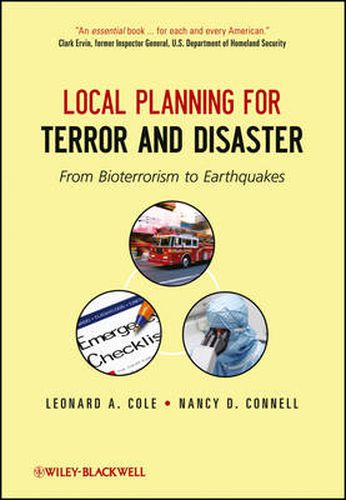Readings Newsletter
Become a Readings Member to make your shopping experience even easier.
Sign in or sign up for free!
You’re not far away from qualifying for FREE standard shipping within Australia
You’ve qualified for FREE standard shipping within Australia
The cart is loading…






Local Planning for Terror and Disaster gives voice to experts in key fields involved with local preparedness, assessing the quality of preparedness in each field, and offering directions for improvement.Introductory chapters provide overviews of terror medicine, security and communications, which are indispensable to successful preparedness, while subsequent chapters concentrate on a particular field and how responders from that field communicate and interact with others during and after an event.Thus, achapter by a physician discusses not only the doctor’s role but how that role is, or should be, coordinated with emergency medical technicians and police.Similarly, chaptersby law enforcement figures also review police responsibilities and interactions with nurses, EMTs, volunteers and other relevant responders. Developed from topics at recent Symposia on Terror Medicine and Security, Local Planning also encompassesaspects of emergency and disaster medicine, as well as techniques for diagnosis, rescue, coordination and security that are distinctive to a terrorist attack.Each chapteralso includes acase study that demonstrates preparedness, or lack thereof, for a real or hypothetical event, including lessons learned, next steps, and areas for improvement inthisglobal erawhich increasingly calls for preparedness at a local level.
$9.00 standard shipping within Australia
FREE standard shipping within Australia for orders over $100.00
Express & International shipping calculated at checkout
Local Planning for Terror and Disaster gives voice to experts in key fields involved with local preparedness, assessing the quality of preparedness in each field, and offering directions for improvement.Introductory chapters provide overviews of terror medicine, security and communications, which are indispensable to successful preparedness, while subsequent chapters concentrate on a particular field and how responders from that field communicate and interact with others during and after an event.Thus, achapter by a physician discusses not only the doctor’s role but how that role is, or should be, coordinated with emergency medical technicians and police.Similarly, chaptersby law enforcement figures also review police responsibilities and interactions with nurses, EMTs, volunteers and other relevant responders. Developed from topics at recent Symposia on Terror Medicine and Security, Local Planning also encompassesaspects of emergency and disaster medicine, as well as techniques for diagnosis, rescue, coordination and security that are distinctive to a terrorist attack.Each chapteralso includes acase study that demonstrates preparedness, or lack thereof, for a real or hypothetical event, including lessons learned, next steps, and areas for improvement inthisglobal erawhich increasingly calls for preparedness at a local level.